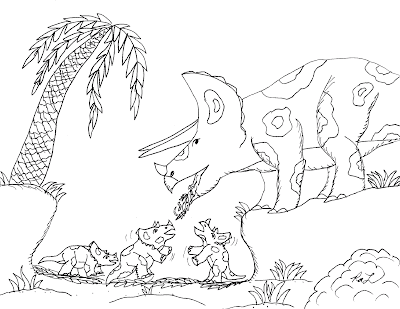T. rex, Triceratops, and Pteranodon Friends
I know that is is improbable that a young T. rex would be friends with a Triceratops and a Pteranodon. But in nature strange things can happen. There is a dinosaur track site in Northern Wyoming (called Red Gulch Dinosaur Track Site) and another track site in Southern Utah (Near St. George). These two sites have hundreds of tracks that show mixed herds may have existed. We can infer this because there are several species of dinosaurs represented by the tracks. . . and it appears that they were possibly traveling or migrating together.
Cretaceous Dinosaurs in a Mixed Herd
Animals of different species will sometimes work together for their mutual benefit. Birds eating bugs off of rhinos and elephants, cleaner fish grooming a shark's mouth, etc. Then of course there is the wolf raven connection... Did you know that Ravens are friends with wolves. Ravens show them where they have seen injured prey animals and the ravens lead the wolf pack to their meal. Then the ravens get the leftovers. Ravens have even been seen and filmed playing with the wolves. So maybe some species of dinos working together is not so far fetched. I highly recommend the movie, Land Before Time. It was one of the first movies to show dinosaurs migrating in a mixed herd, caring for their young, and being more than a dumb lizard.
Raven with Wolf Cub or Pup
Modern animals, like birds, often chew up the food to barf back for their babies to eat. In the very good movie, Walking With Dinosaurs 3D the young Ceratopsian says something like, "MMMMMM Mom's cooking!" There is lots of fossil evidence that Ceratopsians laid eggs and cared for their eggs and then cared for their young as well. In fact most of the dino groups DID lay and guard their eggs and care for their young after they hatched.
Triceratops Mother feeding the Kids
. The only known exception to egg laying dinos caring for their young is the Sauropods. It appears that they laid many many eggs and abandoned them to their fate...kind of like sea turtles do. There is a Sauropod nesting site that goes on for miles in Argentina, It appears that a flooding river buried the site in silt and sand so the eggs became fossilized and were preserved for us. It is thought that a herd of Argentinosaurus migrated into the area, laid their eggs, covered them in leaves and abandoned the nests and their young to their fate. It is thought that only one in a hundred would have survived to also one day reproduce. By the way, Argentinosaurs is the largest known dinosaur yet. It was 115 ft (35 m) long. It possibly weighed around 110 tons. That is 220,000 lbs. (99,790 kg)!! WOW! I'd love to see one of those!
Argentinosaurus gathering Cycad leaves to place upon newly laid Eggs
NOTE: All drawings and content are Copyright 2017 by Robin Andrew Lyman unless otherwise noted. Permission IS granted to print coloring pages for kids or adults to color.





No comments:
Post a Comment